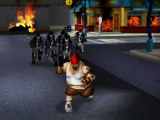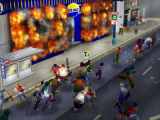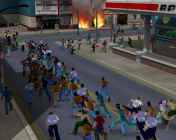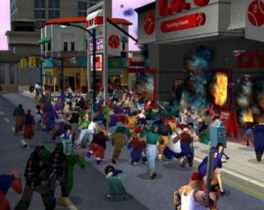| |

 
State of Emergency is one
of the most provocative games to come out in quite some time. The gameís
simple arcade-style gameplay mixes elements of Doom and Final Fight but the gameís
most controversial element is its high intensity action and high degree of
violence. This isnít a bleak title as there is a high-degree of humor involved
that takes the edge off. The biggest question however, is how much fun the game
is once the shock value wears off. The Laser takes a closer look and examines
State of Emergency to see whether the game itself lives up to the controversy.
Following in the adult-oriented footsteps of last yearís hugely popular and
critically acclaimed Grand Theft Auto 3, Rockstarís State of Emergency is
another title thatís already controversial. SOEís gameplay in and of itself
isnít likely to draw much criticism, the intense realism, mass-killing and the
playerís role as a terrorist is likely to upset more than a few players. While
its ultra-violence is unprecedented in console gaming, it isnít nearly as bad
as one would imagine given the hype itís received. The violence here is more
tolerable because its more exaggerated, though there are some grisly elements
such as the ability to blow peoplesí heads off with a shotgun. Itís not as
dark as some would have you believe and is actually rather dark-humored in a
way, sort of like the first Robocop movie, Blade Runner, Brazil or The Running
Man. Itís a satire of violence in an oppressive almost fascist society, but
doesnít have the cynicism that youíd expect. While the game doesnít flinch
in itís displays of graphic violence, there are ways which make the game seem
fun. You never feel like youíre in a realistic environment at all, even though
the locales and layouts of the levels are implemented using realistic maps. The
huge difference is that SOE is a light-hearted title while Rockstarís other
infamous title, GTA3 is gritty and dark. It also helps that itís a
third-person shooter which takes some of the edge off and helps to remove you
from the action.
 The
gameís back story is pretty interesting and sets the stage effectively for the
provocative gameplay to follow. After the collapse of civilian government, an
evil corporation controls the world and has inflicted a totalitarian government
on the populace. However, a resistance group has formed to displace the
corporation, using any means necessary. State of Emergency casts the player as a
revolutionary fighting against the forces of oppression. As you begin each
level, youíre standing at the center of a riot in one of, where the streets
are over-run by hundreds of people in a panic. You play as one of several
different characters and your objective is to defeat an evil fascist
corporation. The objectives are two-fold, to kill the corporation forces and
gangs while inflicting as few civilian casualties as possible. This is a manic
experience and player will find itís almost unavoidable to kill civilians with
all the chaos going on, no matter The
gameís back story is pretty interesting and sets the stage effectively for the
provocative gameplay to follow. After the collapse of civilian government, an
evil corporation controls the world and has inflicted a totalitarian government
on the populace. However, a resistance group has formed to displace the
corporation, using any means necessary. State of Emergency casts the player as a
revolutionary fighting against the forces of oppression. As you begin each
level, youíre standing at the center of a riot in one of, where the streets
are over-run by hundreds of people in a panic. You play as one of several
different characters and your objective is to defeat an evil fascist
corporation. The objectives are two-fold, to kill the corporation forces and
gangs while inflicting as few civilian casualties as possible. This is a manic
experience and player will find itís almost unavoidable to kill civilians with
all the chaos going on, no matter
how
hard they try not to. Players can also gain bonus point for inflicting damage
and destroying vehicles, buildings and other objects. You can also pick up
objects such as mailboxes and crates and smash windows for even more bonus
points. It might seem a little perverse on the surface, but given the context
and motivation youíre provided with, the extreme actions make sense.
Visually, SOE is quite impressive, with detailed
character models, realistic explosions, and intelligently designed environments
adding to the overall intensity. State of Emergency is basically a virtual riot,
and the engine does a good job in recreating the sense of chaos. There are
literally hundreds of civilian characters on each level. This is impressive
enough but each one seems to react to your actions as well. They cower after an
explosion hits nearby and run en masse through the streets. Whatís even more
impressive is the AI seems so realistic with the characters in the game running
around in huge mobs and rampaging recklessly throughout the streets with no
regard to their physical well-being. The production values in State of Emergency
are also enhanced by the sound effects and voice acting. From the strangely
cheerful announcer, to the angry police forces shouting at you and the screams
of the victims, the gameís audio fits the intense nature of the gameplay and
shows a game that doesnít take itself seriously and has a great sense of humor
to it.
Whatís also impressive about State of Emergency are
the aggressive, intelligent enemies. There are two basic kinds, gangs and
corporation forces. They arenít that difficult to beat on their own, but they
attack you in groups when you destroy and kill enough times, which is a cool
effect in and of itself. You can mow them down using one of the weapons, but
they still make for an imposing force that can be hard to defeat, thanks to
their sheer numbers. Even though you might think that the sheer numbers of
opponents will work strongly against you, there are many objects that you can
use to help you survive the chaos. Scattered around each level there are loads
of cool weapons including flame throwers, AK-47s and Uzis that you can pick up
and use. These are all pretty cool and when used right, can inflict a ton of
damage on the environments. You need to be careful with some of the weapons such
as the grenades however, because they can also damage you if they explode when
youíre nearby. The variety of the weapons keeps the game interesting and itís
a lot of fun to use them since they have a different strengths. For example,
clubs, stun guns, sticks and broken bottles are more effective at close range,
while the guns and flame throwers can be used to take out far away enemies. Whatís
cool about SOE is that even If you donít have a weapon, youíre not
completely defenseless because you can engage in hand-to-hand combat with
enemies using kicks and punches, which is cool as well because the characters
can also use their special moves. When you kill one of the corporation forces or
a gang member, theyíll leave behind health and time power-ups as well which
should be collected.
While the gameplay conventions are a lot of fun makes SOE so addictive is that
its controls simple but are also tight and responsive which makes the game easy
to play. Weapons are picked up and discarded with one button and used with
another, players can also strafe when they use guns and turn while standing
still, allowing them to slice through forces like butter. The only problem with
SOEís interface is the camera control scheme that makes it difficult to change
angles. Since the default angle is behind the player and doesnít change until
you change. This is especially aggravating when youíre against a wall and you
try to turn around to fire only to have the camera stuck in the same angle. This
means that you frequently find yourself cornered and have to physically move
your character away from the action to get a good viewpoint. This is the one
areas in SOE thatís not as polished as it could be but you can compensate for
this by learning where the best positions in each level are and avoid the closed
in areas.
 SOE
only other major problem comes in the superficial gameplay which is fun but not
that deep. Itís disappointing that the objectives and weapons stay fairly
static throughout the game. However, it seems that the developers have realized
that the gameplay can become monotonous quickly. To combat this, SOE offers
several different modes of play from the beginning, including kaos and
revolution modes. Kaos Mode is straightforward arcade style action divided into
mini-games. These include different objectives such as killing all the clones on
the level or destroying buildings. Revolution mode is deeper and harder because
it offers more interesting goals. Here, you have to meet up with a fellow
subversive, complete a variety of objectives on a single level, and then report
back. This is more difficult than it sounds but makes the game more addictive.
VIS has done a good job in adding features that extend SOEís appeal beyond
mere mindless shooting, while never losing the visceral, immediate thrill that
makes the game so much fun. SOE
only other major problem comes in the superficial gameplay which is fun but not
that deep. Itís disappointing that the objectives and weapons stay fairly
static throughout the game. However, it seems that the developers have realized
that the gameplay can become monotonous quickly. To combat this, SOE offers
several different modes of play from the beginning, including kaos and
revolution modes. Kaos Mode is straightforward arcade style action divided into
mini-games. These include different objectives such as killing all the clones on
the level or destroying buildings. Revolution mode is deeper and harder because
it offers more interesting goals. Here, you have to meet up with a fellow
subversive, complete a variety of objectives on a single level, and then report
back. This is more difficult than it sounds but makes the game more addictive.
VIS has done a good job in adding features that extend SOEís appeal beyond
mere mindless shooting, while never losing the visceral, immediate thrill that
makes the game so much fun.
To
make things even more interesting, there are several extra modes besides the
main game that extend its depth. After successfully beating levels the game
unlocks additional modes such as a deathmatch, survival and timed games. Players
can also unlock additional locales and characters, adding more challenge a
variety to the experience. The one thing that could have been added would have
been a multi-player mode, but the game is still quite enjoyable without it.
While some will undoubtedly be offended by the violence and use this to condemn
it, that doesnít mean itís totally without merit. The solid gameplay make it
much more than a cheap exercise in shock value because State of Emergency is a
highly entertaining title. Between the simple controls and manic pace it
resembles the simple fun of classic titles such as Robotron and Smash TV. The
elements come together nicely to make playing it quite addictive and the extra
modes add even more replay value to the experience. While players may find it
gets monotonous during extended play, smaller doses of the game provide a
welcome relief valve that offers a solidly entertaining amount of basic mindless
arcade-style fun. You can even turn off the blood and gore if it isnít
tolerable but this is an intense game. Even without the blood, State of
Emergencyís violence means that itís definitely not recommended for
children. This is quite an intense experience but not shocking in comparison to
other shooters and is actually rather silly, if you can believe that. Once you
get over the shock value, itís a fun title with addictive gameplay and
surprisingly high replay value thanks to its extras modes. Like GTA3, State of
Emergency is a solid title thatís loads of fun, and succeeds on its own merits
as a great title despite the controversy surrounding it.
| |
|

